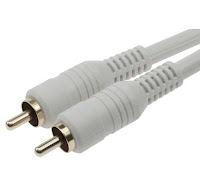SF Cable Blog - Get Expert Tips & Advice on Cables & Accessories
In our blog, we educate customers on the various types of cables, components and accesscories for computer, laptops and mobiles
Here are all That you Need to Know about Audio Cables
- Font size: Larger Smaller
- Hits: 1495
- 0 Comments
- Subscribe to this entry
- Bookmark
There are so many types of audio cables available in the market. And it's a very likely scenario that you bought the wrong audio cable for your music system. Don't worry, you are not alone in this. It is a mistake that everyone makes. Thus, this guide will explain the required basics along with the types and use cases.
1. Jack connector
In any musical equipment, it is one of the most common connection found. The quarter-inch jack is best for electric guitars and amps. It is always ¼ inch or 6.3 mm jack with a single black hoop. It has an insulating ring towards its tip. Known as "Instrument cables", it is best for line-level connections, "Speaker Cable". They are an ideal choice for connecting speakers to amps, guitar heads to cabinets. Moreover, to convert any connector of cable you can use 3.5mm to 2.5mm audio cable or 2.5mm to 3.5mm audio cable. In case you are looking to share your favorite songs with your near ones, you can use an audio splitter cable.
2. ¼-Inch Balanced Jack Connector
This cable is capable of carrying two channels of audio. This does it via Sleeve design, Tip, Ring, the plug itself divided with two black hoops. There is a tip which is the pointy end. Then after the first black hoop, there is a ring section and the sleeve is after the second.
The tip and the ring will carry the left and right channel signals. The sleeve acts as common earth. Its most common use is headphone output, on pianos, keyboards, mixing desks, guitar amps, and hi-fi equipment.
Its balanced audio connections use TRS plugs to make a mono connection which is less susceptible to external noise, particularly when running long cables. You can find such connection on audio interfaces, mixing desks, recording equipment, and PA equipment. It will generally specify if your equipment needs balanced connections.
3. Stereo Mini Jack Connector
It is among the most common audio connections. It is the plug that you usually find on MP3 player headphones, it is a smaller 3.5mm plug. It also has a TRS arrangement with two insulation rings. Also, the top and ring with a sleeve as a common ground carry the left and right channels.
Portable music player headphones are the most common use for it. To connect MP3 players to car stereos and audio connections on devices.
4. The Rica Connector
It looks similar to mini-jack plugs, as they are infrequent use in the home and other equipment. The RCA cable means the Radio Corporation of America is the one who developed this connection. They instigated the replacement of ¼" TRS jack connections on Phonographs in the 1940s to connect to amplifiers.
They are mono connections and unbalanced which are commonly used on DJ mixers, audio interfaces, and frequently on the 'tape in' and 'tape out' connections on mixing desks, and usually features 'tap in' and 'tape out' connections on mixing desks. It features a red right channel connection and a white left channel connection. You can take this cable and share music with your loved ones using an audio splitter cable.
5. The XLR Connector
This connection is common among so many audio applications. Its design is a barrel of approximately 2cm in diameter, with between 3 and 7 pins or holes. 3 pin XLR is the most common format for audio application. Cannon electronics released the Cannon X range. It made them known as 'Cannon' connections, Canon XL was the second revision, and XLR the third one.
XLR connections are in use among a broad range of musical and audio applications. As a golden rule, female XLR plugs normally receive output signals from devices. And mostly you can use the male XLR plugs to plug input devices such as a microphone. Then you plug male XLRs into female sockets and vice versa. Hence, XLR is the trusty mic lead with a female XLR plug on one end and a male XLR on the other.
The SpeakON Connector
The recent audio connection which gives the most amazing audio connection is the speak ON connection. Neutrik developed this speakON connector which is available in 2, 4, and 8 pole iterations. 2 and 4 poles are the most commonly used in everyday audio applications. While designing, they kept in mind the compatibility with high current signals. The female plugs connect to male panel sockets and have a twist-lock mechanism that secures them into the socket. It makes Speakon connectors ideal for live sound applications, most commonly connecting power to loudspeakers. Hence, Speakon to XLR cables very common.
In this article, we tried to cover the most common audio connections. After reading this article, you won't be surprised if your devices are compatible with the audio cable you recently bought. And by mistake, you buy 3.5mm cable in place of 2.5mm cable then you can always use a 3.5mm to 2.5mm audio cable to connect the 2.5mm device.
Looking to buy audio cables for your new music system? Here’s how you can choose the right one for your use.
If you found these articles post useful, here are some other articles that may be of interest.
How to Choose the Correct Audio Cable Splitter for Headphones?

